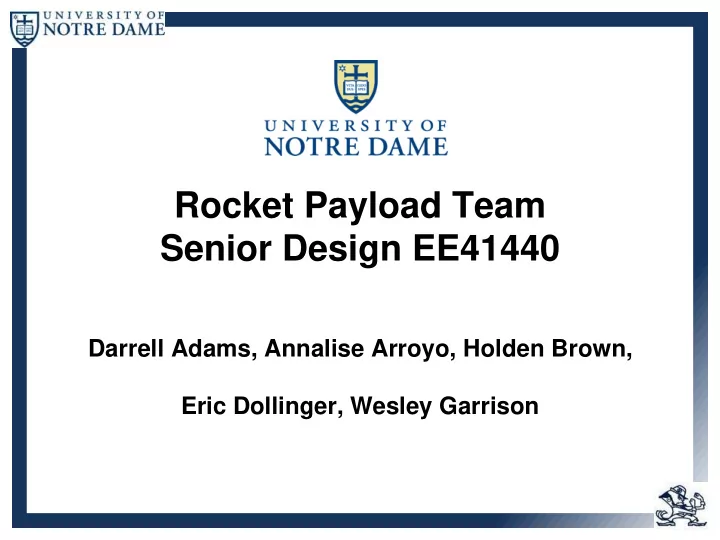

Rocket Payload Team Senior Design EE41440 Darrell Adams, Annalise Arroyo, Holden Brown, Eric Dollinger, Wesley Garrison
Agenda 1. Introduction & Project Description 2. Design Proposal 3. Subsystem Design 4. Board Design 5. Testing and Integration Plans 6. Future Improvements & Conclusion
Project Abstract • Work to design electrical systems for a rover payload on the Notre Dame Rocketry Team (NDRT) in the NASA Student Launch competition
NASA Student Launch • “The NASA Student Launch (SL) is a research -based, competitive, and experiential learning project that provides relevant and cost-effective research and development.” • 2020 Payload challenge: • “Navigate to one of five predetermined sample locations that are each 3 feet in diameter with a colored tarp 10 feet in diameter surrounding the sample area, and collect at least 10 mL of a simulated lunar ice that could be as much as two inches below the ground.”
Design Proposal • Eccentric Crank-Rover • Payload Electrical – Subsystems – Considerations & choices • UAV • Autonomous navigation/Control systems
System Block Diagram
Subsystem Designs • Motors – 2 drive motors and 2 servo motors • Power – 2 11.4V batteries • Sensor – IMU and GPS • Communication – RF Transceiver • Microcontroller/Intelligence – PIC32
Subsystem 1: Motors • Used 2x 3.8A drive motors • 2 servo motors for sample retrieval • 2x5 Sabertooth motor controller used to control drive motors • Serial PWM from PIC32 used to control servo motors Figure X: From Left to Right: 98 RPM Drive Motor, 2x5 Sabertooth Motor Controller
Subsystem 2: Power Management • 2x 11.4V Li-Po batteries provide 3600mAh • With average power consumption, runtime was estimated at 51 minutes
Subsystem 3: Sensor System • Major systems: – IMU – GPS From left to right, MTK3339 GPS • Applications Module, BNO055 IMU – Motor Control System – Autonomous navigation
Subsystem 4: Communication System • Hope RF RFM95W radio module • Manual control • Sending telemetry data to ground station • Sending destination coordinates to rover • Sending deployment signal to release retention on the rover
Subsystem 5: Microcontroller • Microchip PIC32MX795F512H – 6 UART, 4 SPI, 5 I2C – 5 PWM pins – 53 GPIO pins max • Satisfies Rover system requirements – 2 UART, 1 SPI, 1 I2C – 4 PWM signals • Had familiarity with this PIC from previous assignments
Subsystem 5: Intelligence • GPS bearing algorithm: – IMU calculates current heading of rover – fuse IMU data to provide data for calculating heading
Board Design • Careful use of copper pours • Followed example circuits for each component • Every subsystem was tested individually and found to work • Useful extra pins brought to edge of board • 5 volt switching regulator to step down 12V in order to save energy • Linear regulator to step down and clean up 5V to 3.3V MCU and sensor power requirements
Board Assembly -Rover Main Board Retention Board Revision 1 Assembly Revision 1 Assembly
Testing and Integration Plans • Were only able to conduct subsystem testing • Demonstrated successful functionality for the following systems: – Sensors – RF Transceiver – Motor Control – Retention Board Retention Board
Future Improvements • Finish completing subsystem testing, system integration, and software improvements originally planned for after spring break • Improve user control and data interfaces for better decision making by manual or autonomous control • Future project spin-off: design a system to actually analyze and report wirelessly the status of the sample collected (amount, what material etc.)
Conclusion • Successfully designed a robust electrical system and conducted assembly and subsystem testing • Gained professional skills through working with NDRT and handling scheduling and supply chain changes due to COVID-19
Recommend
More recommend